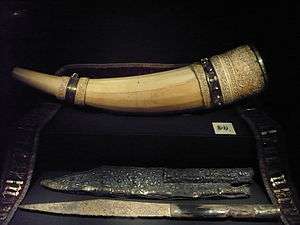Olifant (instrument)
Olifant (an alternate spelling of the word elephant) was the name applied in the Middle Ages to ivory hunting horns made from elephants' tusks. One of the most famous olifants belonged to the legendary Frankish knight Roland, protagonist of The Song of Roland.

In The Song of Roland, Roland carries his olifant while serving on the rearguard of Charlemagne's army. When they are attacked at the Battle of Roncevaux, Oliver tells Roland to use it to call for aid, but he refuses. Roland finally relents, but the battle is already lost. He tries to destroy the olifant along with his sword Durendal, lest they fall into enemy hands. In the end, Roland blows the horn, but the force required bursts his temple, resulting in death.[1] The Karlamagnussaga elaborates (V. c.XIV) that Roland's olifant was a unicorn's horn, hunted in India.
Another famous olifant belonged to Gaston IV, viscount of Béarn, and is now preserved in the Spanish city of Saragosse, which he helped conquer from the Banu Hud.
Salernitan oliphants
The Horn or Oliphant of Ulph, preserved in the treasury of York Minster is one of a group that were carved in Salerno[2] in the first half of the eleventh century. In one of its bands of low-relief carving, addorsed paired griffons have tails that terminate in monstrous eared heads.
The horn of Ulph is most likely the very Horn of Tenure given to York Minster by the Viking nobleman Ulph, who resided in Yorkshire before the reign of Edward the Confessor; thus the Horn of Ulph cannot be dated later than the first half of the eleventh century[3]
A group of surviving ivory horns carved with bands of low relief have been attributed to the same Salerno workshops as the Oliphant of Ulph:[4] the oliphant of the Chartreuse de Portes,[5] an oliphant in the Boston Museum of Fine Arts, the horn of Muri Abbey conserved in Vienna,[6] and oliphants from the treasury of the Basilica of St. Sernin, Toulouse, and Saragossa Cathedral.[7]
References
| Wikimedia Commons has media related to Olifants. |
- The Song of Roland (Oxford text, trans. Douglas David Roy Owen, 1972. George Allen and Unwin, ISBN 0-04-841003-9
- Hanns Swarzenski, "Two Oliphants in the Museum", Bulletin of the Museum of Fine Arts 60 (1962):27-45) esp. pp 42-44.
- Swarzenski 1962:36.
- Swarzenski (1962:34ff, 40).
- Conserved in the Cabinet des Médailles, Bibliothèque nationale, Paris.
- Swartzenski (1962:34) supports T.D.Kendrick's assertion (Kendrick, "The Horn of Ulph", Antiquity 11 (1937:237ff) that the oliphant from Muri was carved in the same workshop as the Horn of Ulph.
- Swartzenski 1962:40 and illus.
